The East Variscan Shear Zone (EVSZ) and Its Regional Mylonitic Complex: A New Geodynamic Interpretation of the Variscan Axial Zone in Sardinia (Italy)?
Abstract
:1. Introduction
2. Materials and Methods
3. Geological Framework of Sardinia
The Variscan Shear Zones in Sardinia
4. Geological Framework of the High-Grade Metamorphic Complex (HGMC)
Structural and Metamorphic Frame of the High-Grade Metamorphic Complex (HGMC)
5. Results
5.1. The Old Gneiss Complex (OGC)
5.2. The New Gneiss Complex (NGC)
5.3. Relationships between the Old Gneiss Complex (OGC), the New Gneiss Complex (NGC), and the Posada Valley Shear Zone (PVSZ)
6. Discussion
Correlations between the NGC and the Variscan Morocco, Corsica, Maures, and Argentera Massifs
7. Conclusions
Author Contributions
Funding
Data Availability Statement
Acknowledgments
Conflicts of Interest
References
- Matte, P. The Variscan Collage and Orogeny (480–290 Ma) and the Tectonic Definition of the Armorica Microplate: A Review. Terra Nova 2001, 13, 122–128. [Google Scholar] [CrossRef]
- Stampfli, G.M.; Borel, G.D. A Plate Tectonic Model for the Paleozoic and Mesozoic Constrained by Dynamic Plate Boundaries and Restored Synthetic Oceanic Isochrons. Earth Planet. Sci. Lett. 2002, 196, 17–33. [Google Scholar] [CrossRef]
- Stampfli, G.M.; Kozur, H.W. Europe from the Variscan to the Alpine Cycles. In European Lithosphere Dynamics; Gee, D.G., Stephenson, R.A., Eds.; Geological Society of London: London, UK, 2006; Volume 32, ISBN 978-1-86239-212-0. [Google Scholar]
- Von Raumer, J.F.; Bussy, F.; Stampfli, G.M. The Variscan Evolution in the External Massifs of the Alps and Place in Their Variscan Framework. Comptes Rendus Geosci. 2009, 341, 239–252. [Google Scholar] [CrossRef]
- Michard, A.; Soulaimani, A.; Hoepffner, C.; Ouanaimi, H.; Baidder, L.; Rjimati, E.C.; Saddiqi, O. The South-Western Branch of the Variscan Belt: Evidence from Morocco. Tectonophysics 2010, 492, 1–24. [Google Scholar] [CrossRef]
- Padovano, M.; Elter, F.M.; Pandeli, E.; Franceschelli, M. The East Variscan Shear Zone: New Insights into Its Role in the Late Carboniferous Collision in Southern Europe. Int. Geol. Rev. 2012, 54, 957–970. [Google Scholar] [CrossRef]
- Padovano, M.; Dörr, W.; Elter, F.M.; Gerdes, A. The East Variscan Shear Zone: Geochronological Constraints from the Capo Ferro Area (NE Sardinia, Italy). Lithos 2014, 196–197, 27–41. [Google Scholar] [CrossRef]
- Edel, J.B.; Schulmann, K.; Lexa, O.; Lardeaux, J.M. Late Palaeozoic Palaeomagnetic and Tectonic Constraints for Amalgamation of Pangea Supercontinent in the European Variscan Belt. Earth-Sci. Rev. 2018, 177, 589–612. [Google Scholar] [CrossRef]
- Elter, F.M.; Gaggero, L.; Mantovani, F.; Pandeli, E.; Costamagna, L.G. The Atlas-East Variscan -Elbe Shear System and Its Role in the Formation of the Pull-Apart Late Palaeozoic Basins. Int. J. Earth Sci. 2020, 109, 739–760. [Google Scholar] [CrossRef]
- Martínez Catalán, J.R.; Schulmann, K.; Ghienne, J.-F. The Mid-Variscan Allochthon: Keys from Correlation, Partial Retrodeformation and Plate-Tectonic Reconstruction to Unlock the Geometry of a Non-Cylindrical Belt. Earth-Sci. Rev. 2021, 220, 103700. [Google Scholar] [CrossRef]
- Bolle, O.; Corsini, M.; Diot, H.; Laurent, O.; Melis, R. Late-Orogenic Evolution of the Southern European Variscan Belt Constrained by Fabric Analysis and Dating of the Camarat Granitic Complex and Coeval Felsic Dykes (Maures–Tanneron Massif, SE France). Tectonics 2023, 42, e2022TC007310. [Google Scholar] [CrossRef]
- Matte, P. Accretionary History and Crustal Evolution of the Variscan Belt in Western Europe. Tectonophysics 1991, 196, 309–337. [Google Scholar] [CrossRef]
- Schulmann, K.; Edel, J.-B.; Martínez Catalán, J.R.; Mazur, S.; Guy, A.; Lardeaux, J.-M.; Ayarza, P.; Palomeras, I. Tectonic Evolution and Global Crustal Architecture of the European Variscan Belt Constrained by Geophysical Data. Earth-Sci. Rev. 2022, 234, 104195. [Google Scholar] [CrossRef]
- Ábalos, B.; Carreras, J.; Druguet, E.; Viruete, J.E.; Pugnaire, M.T.G.; Alvarez, S.L.; Quesada, C.; Fernández, L.R.R.; Gil-Ibarguchi, J.I. Variscan and Pre-Variscan Tectonics. In The Geology of Spain; Gibbons, W., Moreno, T., Eds.; Geological Society of London: London, UK, 2002; ISBN 978-1-86239-127-7. [Google Scholar]
- Helbing, H.; Frisch, W.; Bons, P.D. South Variscan Terrane Accretion: Sardinian Constraints on the Intra-Alpine Variscides. J. Struct. Geol. 2006, 28, 1277–1291. [Google Scholar] [CrossRef]
- Festa, V.; Caggianelli, A.; Kruhl, J.H.; Liotta, D.; Prosser, G.; Gueguen, E.; Paglionico, A. Late-Hercynian Shearing during Crystallization of Granitoid Magmas (Sila Massif, Southern Italy): Regional Implications. Geodin. Acta 2006, 19, 185–195. [Google Scholar] [CrossRef]
- Molli, G.; Montanini, A.; Frank, W. Morb-Derived Variscan Amphibolites in the Northern Apennine Basement: The Cerreto Metamorphic Slices (Tuscan-Emilian Apennine, Nw Italy). Ofioliti 2002, 27, 17–30. [Google Scholar] [CrossRef]
- Von Raumer, J.F.; Stampfli, G.M.; Bussy, F. Gondwana-Derived Microcontinents—The Constituents of the Variscan and Alpine Collisional Orogens. Tectonophysics 2003, 365, 7–22. [Google Scholar] [CrossRef]
- Torsvik, T.H.; Cocks, L.R.M. Gondwana from Top to Base in Space and Time. Gondwana Res. 2013, 24, 999–1030. [Google Scholar] [CrossRef]
- Corsini, M.; Rolland, Y. Late Evolution of the Southern European Variscan Belt: Exhumation of the Lower Crust in a Context of Oblique Convergence. C. R. Géosci. 2009, 341, 214–223. [Google Scholar] [CrossRef]
- Faure, M.; Rossi, P.; Gaché, J.; Melleton, J.; Frei, D.; Li, X.; Lin, W. Variscan Orogeny in Corsica: New Structural and Geochronological Insights, and Its Place in the Variscan Geodynamic Framework. Int. J. Earth Sci. 2014, 103, 1533–1551. [Google Scholar] [CrossRef]
- Gutiérrez-Alonso, G.; Fernández-Suárez, J.; Weil, A.B.; Brendan Murphy, J.; Damian Nance, R.; Corfú, F.; Johnston, S.T. Self-Subduction of the Pangaean Global Plate. Nat. Geosci. 2008, 1, 549–553. [Google Scholar] [CrossRef]
- Ballèvre, M.; Manzotti, P.; Dal Piaz, G.V. Pre-Alpine (Variscan) Inheritance: A Key for the Location of the Future Valaisan Basin (Western Alps). Tectonics 2018, 37, 786–817. [Google Scholar] [CrossRef]
- Weil, A.B.; Gutiérrez-Alonso, G.; Johnston, S.T.; Pastor-Galán, D. Kinematic Constraints on Buckling a Lithospheric-Scale Orocline along the Northern Margin of Gondwana: A Geologic Synthesis. Tectonophysics 2013, 582, 25–49. [Google Scholar] [CrossRef]
- Martínez Catalán, J.R. Are the Oroclines of the Variscan Belt Related to Late Variscan Strike-Slip Tectonics? Terra Nova 2011, 23, 241–247. [Google Scholar] [CrossRef]
- Dias, R.; Hadani, M.; Leal Machado, I.; Adnane, N.; Hendaq, Y.; Madih, K.; Matos, C. Variscan Structural Evolution of the Western High Atlas and the Haouz Plain (Morocco). J. Afr. Earth Sci. 2011, 61, 331–342. [Google Scholar] [CrossRef]
- Neubauer, F.; Handler, R. Variscan Orogeny in the Eastern Alps and Bohemian Massif: How Do These Units Correlate. Mitt. Österr. Geol. Ges. 2000, 92, 35–59. [Google Scholar]
- Elter, F.M.; Padovano, M.; Kraus, R.K. The Emplacement of Variscan HT Metamorphic Rocks Linked to the Interaction between Gondwana and Laurussia: Structural Constraints in NE Sardinia (Italy). Terra Nova 2010, 22, 369–377. [Google Scholar] [CrossRef]
- Carosi, R.; Frassi, C.; Montomoli, C. Deformation during Exhumation of Medium- and High-Grade Metamorphic Rocks in the Variscan Chain in Northern Sardinia (Italy). Geol. J. 2009, 44, 280–305. [Google Scholar] [CrossRef]
- Cruciani, G.; Montomoli, C.; Carosi, R.; Franceschelli, M.; Puxeddu, M. Continental Collision from Two Perspectives: A Review of Variscan Metamorphism and Deformation in Northern Sardinia. Period. Mineral. 2015, 84, 657–699. [Google Scholar] [CrossRef]
- Franceschelli, M.; Puxeddu, M.; Cruciani, G. Variscan Metamorphism in Sardinia, Italy: Review and Discussion. J. Virtual Explor. 2005, 19, 2–36. [Google Scholar] [CrossRef]
- Costamagna, L.G.; Elter, F.M.; Gaggero, L.; Mantovani, F. Contact Metamorphism in Middle Ordovician Arc Rocks (SW Sardinia, Italy): New Paleogeographic Constraints. Lithos 2016, 264, 577–593. [Google Scholar] [CrossRef]
- Conti, P.; Carmignani, L.; Funedda, A. Change of Nappe Transport Direction during the Variscan Collisional Evolution of Central-Southern Sardinia (Italy). Tectonophysics 2001, 332, 255–273. [Google Scholar] [CrossRef]
- Carosi, R.; Palmeri, R. Orogen-Parallel Tectonic Transport in the Variscan Belt of Northeastern Sardinia (Italy): Implications for the Exhumation of Medium-Pressure Metamorphic Rocks. Geol. Mag. 2002, 139, 497–511. [Google Scholar] [CrossRef]
- Helbing, H.; Tiepolo, M. Age Determination of Ordovician Magmatism in NE Sardinia and Its Bearing on Variscan Basement Evolution. J. Geol. Soc. 2005, 162, 689–700. [Google Scholar] [CrossRef]
- Carosi, R.; D’Addario, E.; Mammoliti, E.; Montomoli, C.; Simonetti, M. Geology of the Northwestern Portion of the Ferriere-Mollieres Shear Zone, Argentera Massif, Italy. J. Maps 2016, 12, 466–475. [Google Scholar] [CrossRef]
- Carosi, R.; Montomoli, C.; Iacopini, D.; Petroccia, A.; Simonetti, M.; Oggiano, G. Geology of the Asinara Island (Sardinia, Italy). J. Maps 2024, 20, 2317136. [Google Scholar] [CrossRef]
- Elter, F.M.; Corsi, B.; Cricca, P.; Muzio, G. The South-Western Alpine Foreland: Correlation between Two Sectors of the Variscan Chain Belonging to “Stable Europe”: Sardinia(-)Corsica and the Maures Massif (South-Eastern France). Geodin. Acta 2004, 17, 31–40. [Google Scholar] [CrossRef]
- Corsi, B.; Elter, F.M. Eo-Variscan (Devonian?) Melting in the High Grade Metamorphic Complex of the NE Sardinia Belt (Italy). Geodin. Acta 2006, 19, 155–164. [Google Scholar] [CrossRef]
- Cruciani, G.; Franceschelli, M.; Elter, F.M.; Puxeddu, M.; Utzeri, D. Petrogenesis of Al–Silicate-Bearing Trondhjemitic Migmatites from NE Sardinia, Italy. Lithos 2008, 102, 554–574. [Google Scholar] [CrossRef]
- Elter, F.M.; Musumeci, G.; Pertusati, P.C. Late Hercynian Shear Zones in Sardinia. Tectonophysics 1990, 176, 387–404. [Google Scholar] [CrossRef]
- Elter, F.M.; Faure, M.; Ghezzo, C.; Corsi, B. Late Hercynian Shear Zones in Northeastern Sardinia (Italy). Géologie Fr. 1999, 2, 3–16. [Google Scholar]
- Carmignani, L.; Carosi, R.; Di Pisa, A.; Gattiglio, M.; Musumeci, G.; Oggiano, G.; Carlo Pertusati, P. The Hercynian Chain in Sardinia (Italy). Geodin. Acta 1994, 7, 31–47. [Google Scholar] [CrossRef]
- Carmignani, L.; Oggiano, G.; Funedda, A.; Conti, P.; Pasci, S. The Geological Map of Sardinia (Italy) at 1:250,000 Scale. J. Maps 2016, 12, 826–835. [Google Scholar] [CrossRef]
- Carosi, R.; Montomoli, C.; Tiepolo, M.; Frassi, C. Geochronological Constraints on Post-Collisional Shear Zones in the Variscides of Sardinia (Italy). Terra Nova 2012, 24, 42–51. [Google Scholar] [CrossRef]
- Carosi, R.; Montomoli, C.; Iaccarino, S.; Benetti, B.; Petroccia, A.; Simonetti, M. Constraining the Timing of Evolution of Shear Zones in Two Collisional Orogens: Fusing Structural Geology and Geochronology. Geosciences 2022, 12, 231. [Google Scholar] [CrossRef]
- Di Vincenzo, G. The Relationship between Tectono-Metamorphic Evolution and Argon Isotope Records in White Mica: Constraints from in Situ 40Ar-39Ar Laser Analysis of the Variscan Basement of Sardinia. J. Petrol. 2004, 45, 1013–1043. [Google Scholar] [CrossRef]
- Genier, F.; Bussy, F.; Epard, J.-L.; Baumgartner, L. Water-Assisted Migmatization of Metagraywackes in a Variscan Shear Zone, Aiguilles-Rouges Massif, Western Alps. Lithos 2008, 102, 575–597. [Google Scholar] [CrossRef]
- Corsini, M.; Ruffet, G.; Caby, R. Alpine and Late-Hercynian Geochronological Constraints in the Argentera Massif (Western Alps). Eclogae Geol. Helvetiae 2004, 97, 3–15. [Google Scholar] [CrossRef]
- Franceschelli, M.; Columbu, S.; Elter, F.M.; Cruciani, G. Giant Garnet Crystals in Wollastonite–Grossularite–Diopside-Bearing Marbles from Tamarispa (NE Sardinia, Italy): Geosite Potential, Conservation, and Evaluation as Part of a Regional Environmental Resource. Geoheritage 2021, 13, 96. [Google Scholar] [CrossRef]
- Ferrara, G.; Ricci, C.A.; Rita, F. Isotopic Ages and Tectono-Metamorphic History of the Metamorphic Basement of North-Eastern Sardinia. Contrib. Mineral. Petrol. 1978, 68, 99–106. [Google Scholar] [CrossRef]
- Giacomini, F.; Bomparola, R.M.; Ghezzo, C.; Guldbransen, H. The Geodynamic Evolution of the Southern European Variscides: Constraints from the U/Pb Geochronology and Geochemistry of the Lower Palaeozoic Magmatic-Sedimentary Sequences of Sardinia (Italy). Contrib. Mineral. Petrol. 2006, 152, 19–42. [Google Scholar] [CrossRef]
- Cruciani, G.; Franceschelli, M.; Carosi, R.; Montomoli, C. P-T Path from Garnet Zoning in Pelitic Schist from NE Sardinia, Italy: Further Constraints on the Metamorphic and Tectonic Evolution of the North Sardinia Variscan Belt. Lithos 2022, 428–429, 106836. [Google Scholar] [CrossRef]
- Fossen, H.; Cavalcante, G.C.G. Shear Zones—A Review. Earth-Sci. Rev. 2017, 171, 434–455. [Google Scholar] [CrossRef]
- Passchier, C.W.; Trouw, R.A.J. Microtectonics; Springer: Berlin/Heidelberg, Germany, 1996; ISBN 978-3-540-64003-5. [Google Scholar]
- Cappelli, B.; Liotta, D.; Cocozza, T. Università degli studi di Siena Dipartimento di scienze della Terra. In Geologia del Basamento Italiano: Convegno in Memoria di Tommaso Cocozza Accademia dei Fisiocritici, Siena, 21–22 Marzo 1991 Abstracts/Coordinamento Editoriale a Cura di Beatrice Cappelli e Domenico Liotta; Università, Dipartimento di Scienze della Terra: Siena, Italy, 1991. [Google Scholar]
- Cruciani, G.; Franceschelli, M.; Scodina, M.; Puxeddu, M. Garnet zoning in kyanite-bearing eclogite from golfo aranci: New data on the early prograde P–T evolution in NE Sardinia, Italy. Geol. J. 2019, 54, 190–205. [Google Scholar] [CrossRef]
- Cruciani, G.; Franceschelli, M.; Groppo, C.; Spano, M.E. Metamorphic Evolution of Non-Equilibrated Granulitized Eclogite from Punta de Li Tulchi (Variscan Sardinia) Determined through Texturally Controlled Thermodynamic Modelling. J. Metamorph. Geol. 2012, 30, 667–685. [Google Scholar] [CrossRef]
- Franceschelli, M.; Eltrudis, A.; Memmi, I.; Palmeri, R.; Carcangiu, G. Multi-Stage Metamorphic Re-Equilibration in Eclogitic Rocks from the Hercynian Basement of NE Sardinia (Italy). Mineral. Petrol. 1998, 62, 167–193. [Google Scholar] [CrossRef]
- Palmeri, R.; Fanning, M.; Franceschelli, M.; Memmi, I.; Ricci, C.A. SHRIMP Dating of Zircons in Eclogite from the Variscan Basement in North-Eastern Sardinia (Italy). Neues Jahrb. Mineral.—Monatshefte 2004, 6, 275–288. [Google Scholar] [CrossRef]
- Cruciani, G.; Franceschelli, M.; Musumeci, G.; Scodina, M. Geology of the Montigiu Nieddu Metamorphic Basement, NE Sardinia (Italy). J. Maps 2020, 16, 543–551. [Google Scholar] [CrossRef]
- Massonne, H.-J.; Cruciani, G.; Franceschelli, M. Geothermobarometry on Anatectic Melts—A High-Pressure Variscan Migmatite from Northeast Sardinia. Int. Geol. Rev. 2013, 55, 1490–1505. [Google Scholar] [CrossRef]
- Mukherjee, S. Atlas of Shear Zone Structures in Meso-Scale; Springer Geology; Springer International Publishing: Cham, Switzerland, 2014; ISBN 978-3-319-00088-6. [Google Scholar]
- Scodina, M.; Cruciani, G.; Franceschelli, M. Metamorphic Evolution and P–T Path of the Posada Valley Amphibolites: New Insights on the Variscan High Pressure Metamorphism in NE Sardinia, Italy. C. R. Géosci. 2021, 353, 227–246. [Google Scholar] [CrossRef]
- Frassi, C. Structure of the Variscan Metamorphic Complexes in the Central Transect of the Posada-Asinara Line (SW Gallura Region, Northern Sardinia, Italy). J. Maps 2015, 11, 136–145. [Google Scholar] [CrossRef]
- Oggiano, G.; Funedda, A.; Carmignani, L.; Pasci, S. The Sardinia-Corsica Microplate and Its Role in the Northern Apennine Geodynamics: New Insights from the Tertiary Intraplate Strike-Slip Tectonics of Sardinia. Ital. J. Geosci. 2009, 128, 527–539. [Google Scholar] [CrossRef]
- Cruciani, G.; Franceschelli, M.; Iaccarino, S.; Montomoli, C.; Carosi, R.; Scodina, M. P–T Conditions in Mylonitic Gneiss from Posada Shear Zone, NE Sardinia. In Proceedings of the Abstracts del Congresso SIMP-SGI-SOGeI-AIV, Pisa, Italy, 1 January 2017. [Google Scholar]
- Hoepffner, C.; Houari, M.R.; Bouabdelli, M. Tectonics of the North African Variscides (Morocco, Western Algeria): An Outline. C. R. Géosci. 2006, 338, 25–40. [Google Scholar] [CrossRef]
- Ait Daoud, M.; Essalhi, A.; Essalhi, M.; Toummite, A. The Role of Variscan Shortening in the Control of Mineralization Deposition in Tadaout-Tizi n’rsas Mining District (Eastern Anti-Atlas, Morocco). Bull. Miner. Res. Explor. 2019, 161, 13–32. [Google Scholar] [CrossRef]
- Admou, S.; Branquet, Y.; Badra, L.; Barbanson, L.; Outhounjite, M.; Khalifa, A.; Zouhair, M.; Maacha, L. The Hajjar Regional Transpressive Shear Zone (Guemassa Massif, Morocco): Consequences on the Deformation of the Base-Metal Massive Sulfide Ore. Minerals 2018, 8, 435. [Google Scholar] [CrossRef]
- Houari, M.-R.; Hoepffner, C. Late Carboniferous Dextral Wrench-Dominated Transpression along the North African Craton Margin (Eastern High-Atlas, Morocco). J. Afr. Earth Sci. 2003, 37, 11–24. [Google Scholar] [CrossRef]
- Rossi, P.; Oggiano, G.; Cocherie, A. A Restored Section of the “Southern Variscan Realm” across the Corsica–Sardinia Microcontinent. Comptes Rendus Geosci. 2009, 341, 224–238. [Google Scholar] [CrossRef]
- Dulcetta, L.; Faure, M.; Rossi, P.; Cruciani, G.; Franceschelli, M. Geology of the Zicavo Metamorphic Complex, Southern Corsica (France). J. Maps 2023, 19, 2264320. [Google Scholar] [CrossRef]
- Li, X.-H.; Faure, M.; Lin, W. From Crustal Anatexis to Mantle Melting in the Variscan Orogen of Corsica (France): SIMS U–Pb Zircon Age Constraints. Tectonophysics 2014, 634, 19–30. [Google Scholar] [CrossRef]
- Cruciani, G.; Franceschelli, M.; Massonne, H.-J.; Musumeci, G. Evidence of Two Metamorphic Cycles Preserved in Garnet from Felsic Granulite in the Southern Variscan Belt of Corsica, France. Lithos 2021, 380–381, 105919. [Google Scholar] [CrossRef]
- Giacomini, F.; Dallai, L.; Carminati, E.; Tiepolo, M.; Ghezzo, C. Exhumation of a Variscan Orogenic Complex: Insights into the Composite Granulitic–Amphibolitic Metamorphic Basement of South-East Corsica (France). J. Metamorph. Geol. 2008, 26, 403–436. [Google Scholar] [CrossRef]
- Paquette, J.-L.; Ménot, R.-P.; Pin, C.; Orsini, J.-B. Episodic and Short-Lived Granitic Pulses in a Post-Collisional Setting: Evidence from Precise U–Pb Zircon Dating through a Crustal Cross-Section in Corsica. Chem. Geol. 2003, 198, 1–20. [Google Scholar] [CrossRef]
- Bellot, J.-P. The Palaeozoic Evolution of the Maures Massif (France) and Its Potential Correlation with Others Areas of the Variscan Belt: A Review. J. Virtual Explor. 2005, 19, 1–23. [Google Scholar] [CrossRef]
- Morillon, A.-C.; Féraud, G.; Sosson, M.; Ruffet, G.; Crevola, G.; Lerouge, G. Diachronous Cooling on Both Sides of a Major Strike Slip Fault in the Variscan Maures Massif (South-East France), as Deduced from a Detailed 40Ar/39Ar Study. Tectonophysics 2000, 321, 103–126. [Google Scholar] [CrossRef]
- Compagnoni, R.; Ferrando, S.; Lombardo, B.; Radulesco, N.; Rubatto, D. Paleo-European Crust of the Italian Western Alps: Geological History of the Argentera Massif and Comparison with Mont Blanc-Aiguilles Rouges and Maures-Tanneron Massifs. J. Virtual Explor. 2010, 36, 1–30. [Google Scholar] [CrossRef]
- Simonetti, M.; Carosi, R.; Montomoli, C.; Langone, A.; D’Addario, E.; Mammoliti, E. Kinematic and Geochronological Constraints on Shear Deformation in the Ferriere-Mollières Shear Zone (Argentera-Mercantour Massif, Western Alps): Implications for the Evolution of the Southern European Variscan Belt. Int. J. Earth Sci. 2018, 107, 2163–2189. [Google Scholar] [CrossRef]
- Mantovani, F.; Elter, F.M.; Pandeli, E.; Briguglio, A.; Piazza, M. The Portofino Conglomerate (Eastern Liguria, Northern Italy): Provenance, Age and Geodynamic Implications. Geosciences 2023, 13, 154. [Google Scholar] [CrossRef]
- Edel, J.; Dubois, D.; Marchant, R.; Hernandez, J.; Cosca, M. La Rotation Miocène Inférieur Du Bloc Corso-Sarde. Nouvelles Contraintes Paléomagnétiques Sur La Fin Du Mouvement. Bull. Soc. Geol. Fr. 2001, 172, 275–283. [Google Scholar] [CrossRef]
- Casini, L.; Cuccuru, S.; Puccini, A.; Oggiano, G.; Rossi, P. Evolution of the Corsica–Sardinia Batholith and Late-Orogenic Shearing of the Variscides. Tectonophysics 2015, 646, 65–78. [Google Scholar] [CrossRef]
- Edel, J.-B.; Schulmann, K.; Lexa, O.; Diraison, M.; Géraud, Y. Permian Clockwise Rotations of the Ebro and Corso-Sardinian Blocks during Iberian–Armorican Oroclinal Bending: Preliminary Paleomagnetic Data from the Catalan Coastal Range (NE Spain). Tectonophysics 2015, 657, 172–186. [Google Scholar] [CrossRef]
- Edel, J.-B.; Casini, L.; Oggiano, G.; Rossi, P.; Schulmann, K. Early Permian 90° Clockwise Rotation of the Maures–Estérel–Corsica–Sardinia Block Confirmed by New Palaeomagnetic Data and Followed by a Triassic 60° Clockwise Rotation. Geol. Soc. Lond. Spec. Publ. 2014, 405, 333–361. [Google Scholar] [CrossRef]
- Edel, J.B. The Rotations of the Variscides during the Carboniferous Collision: Paleomagnetic Constraints from the Vosges and the Massif Central (France). Tectonophysics 2001, 332, 69–92. [Google Scholar] [CrossRef]


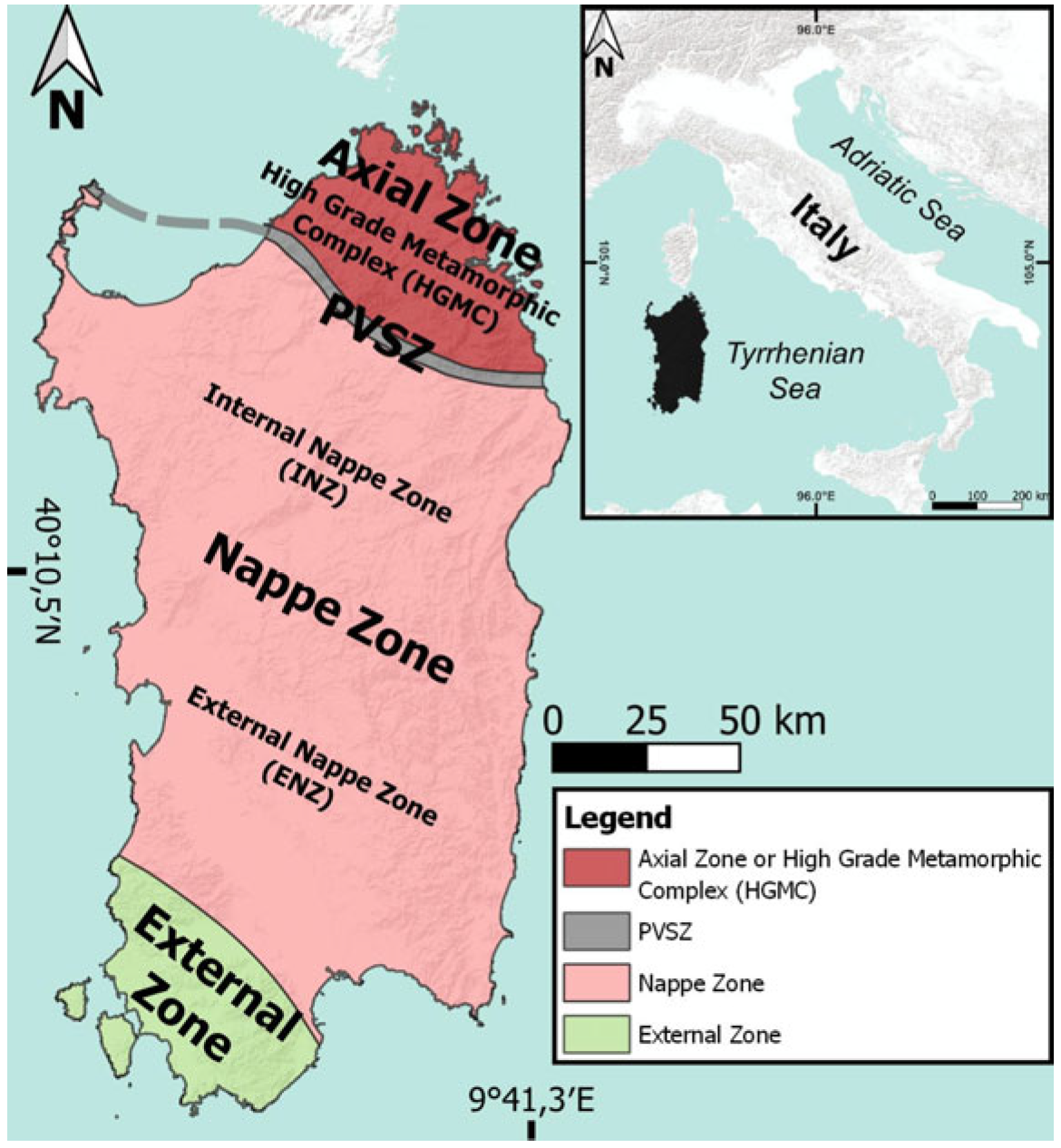

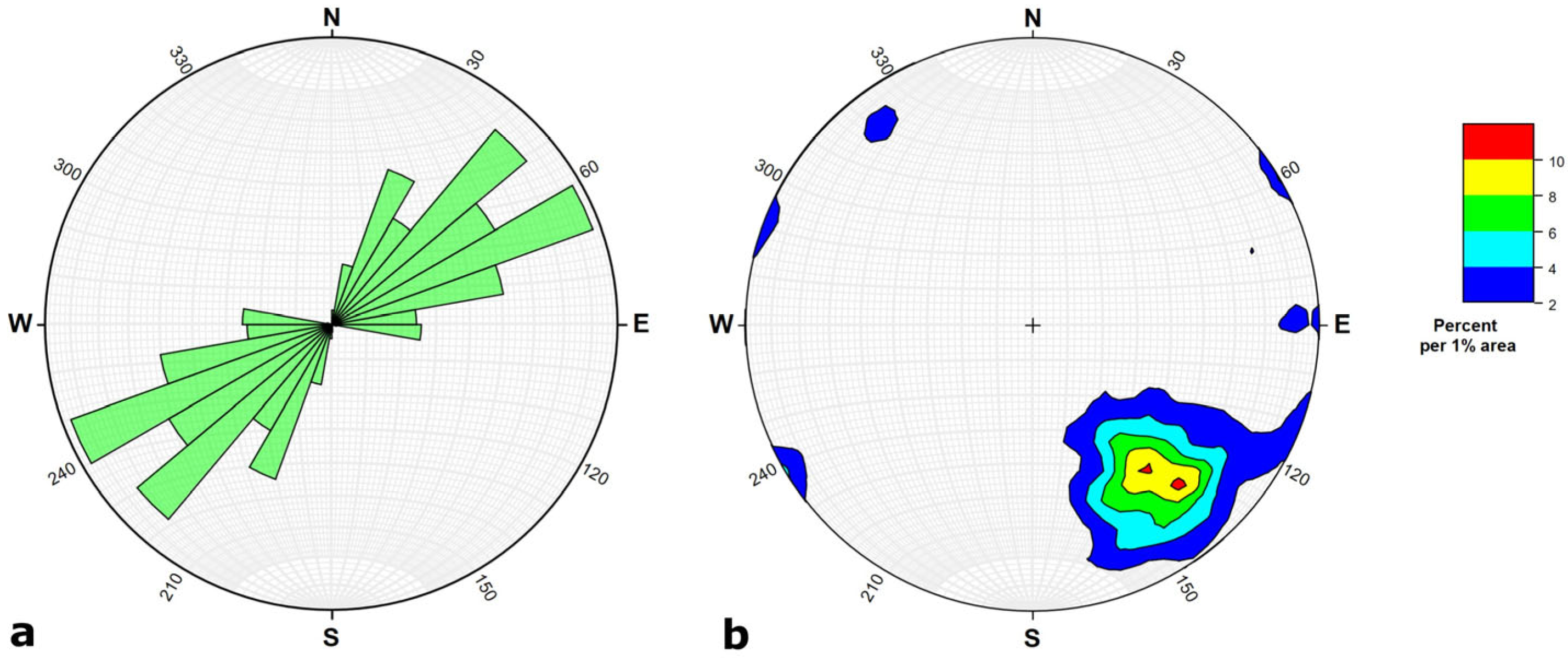
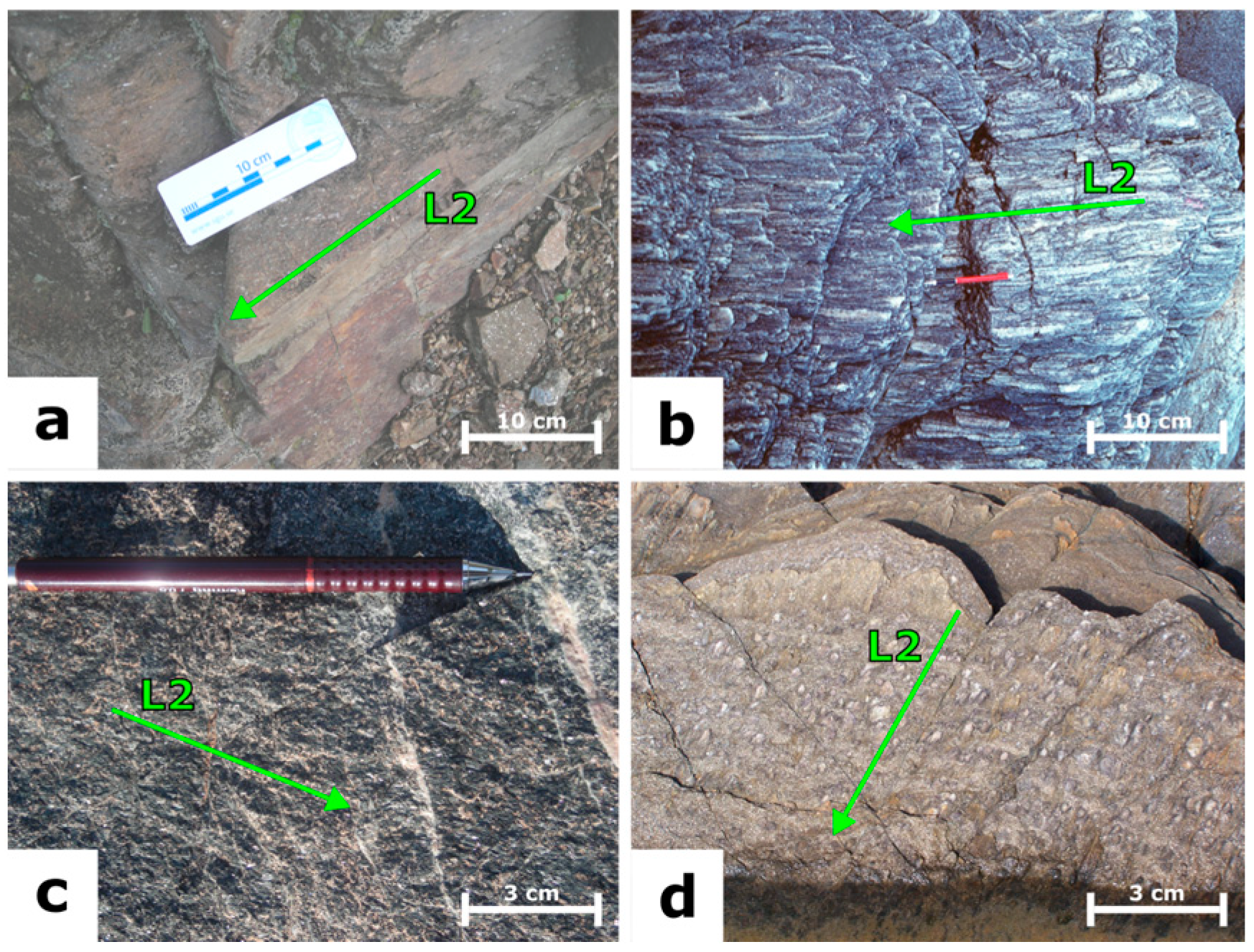
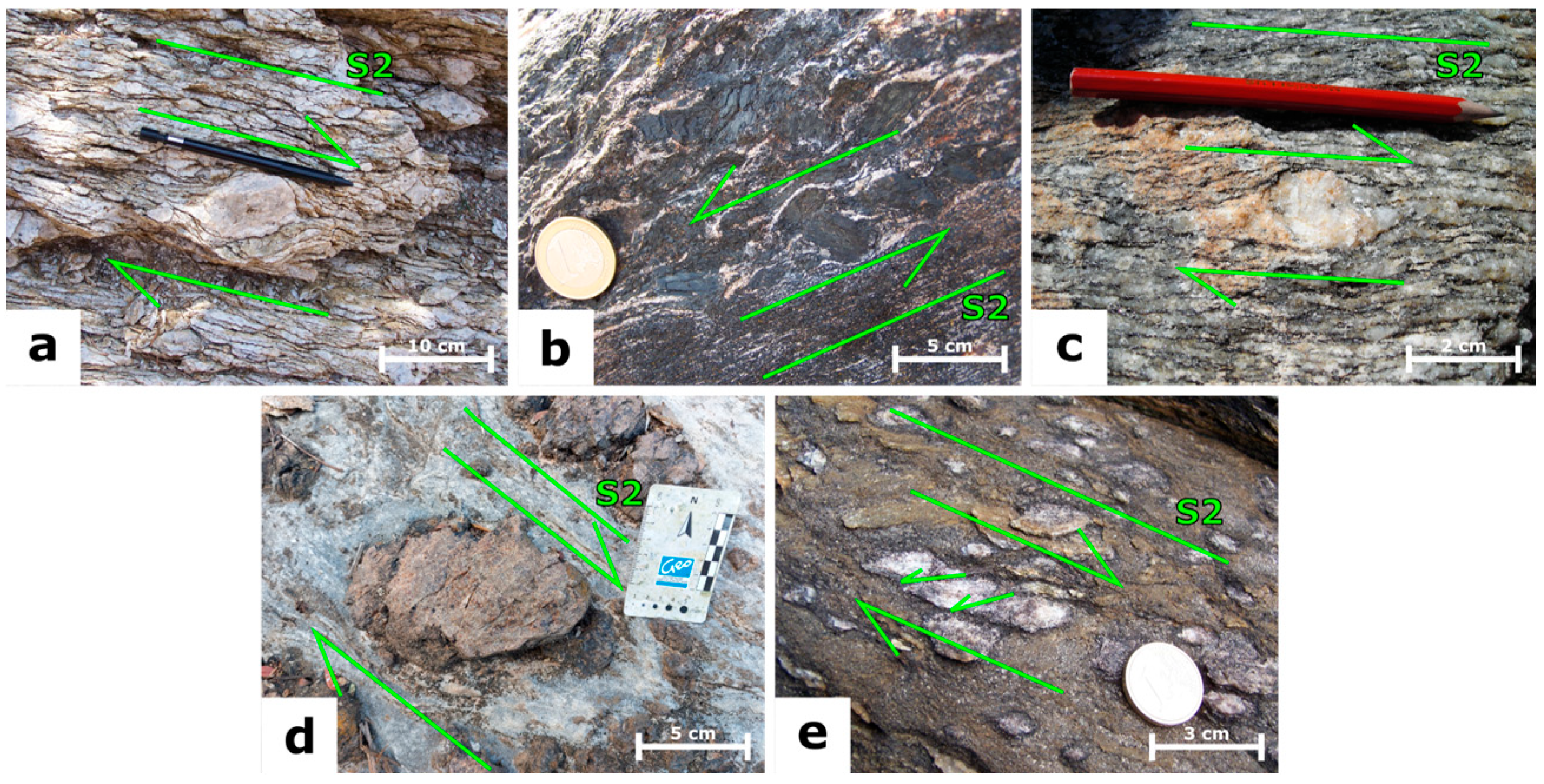

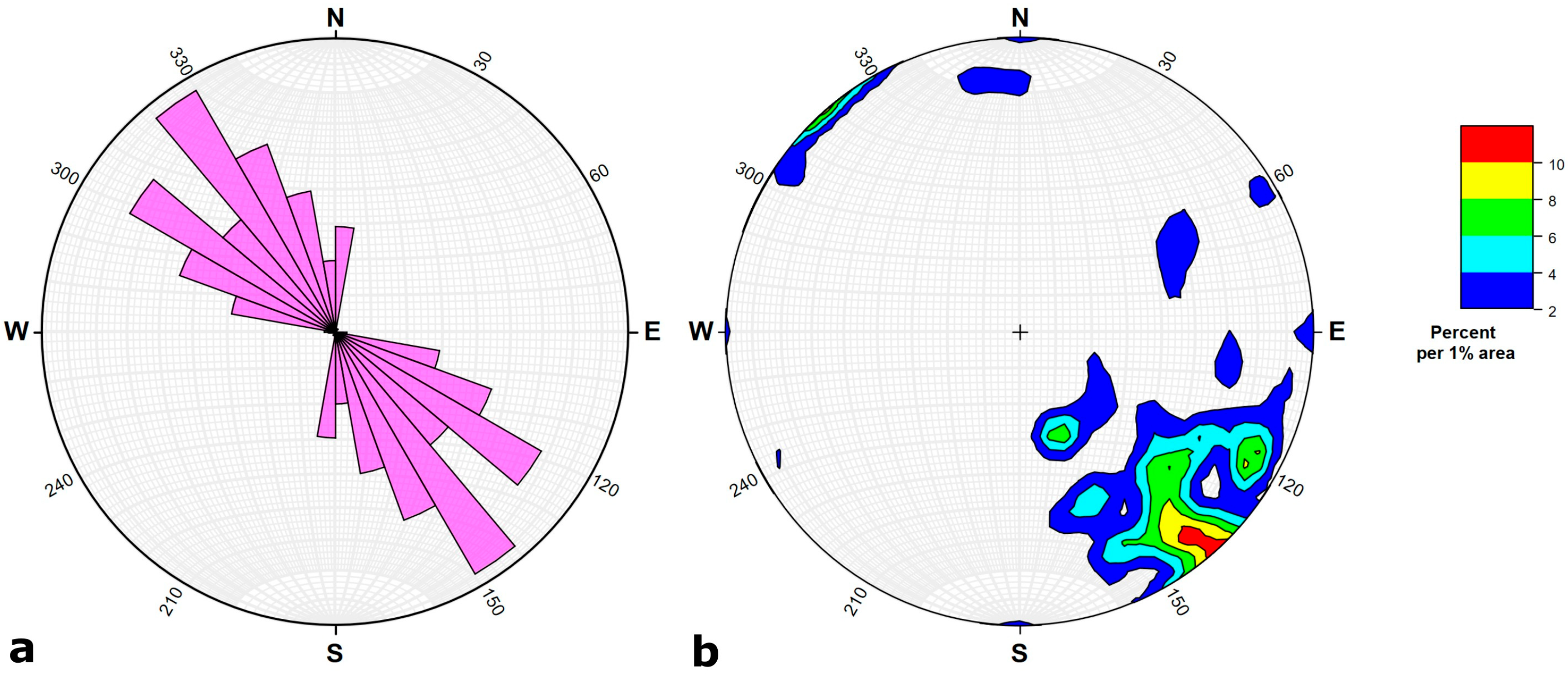

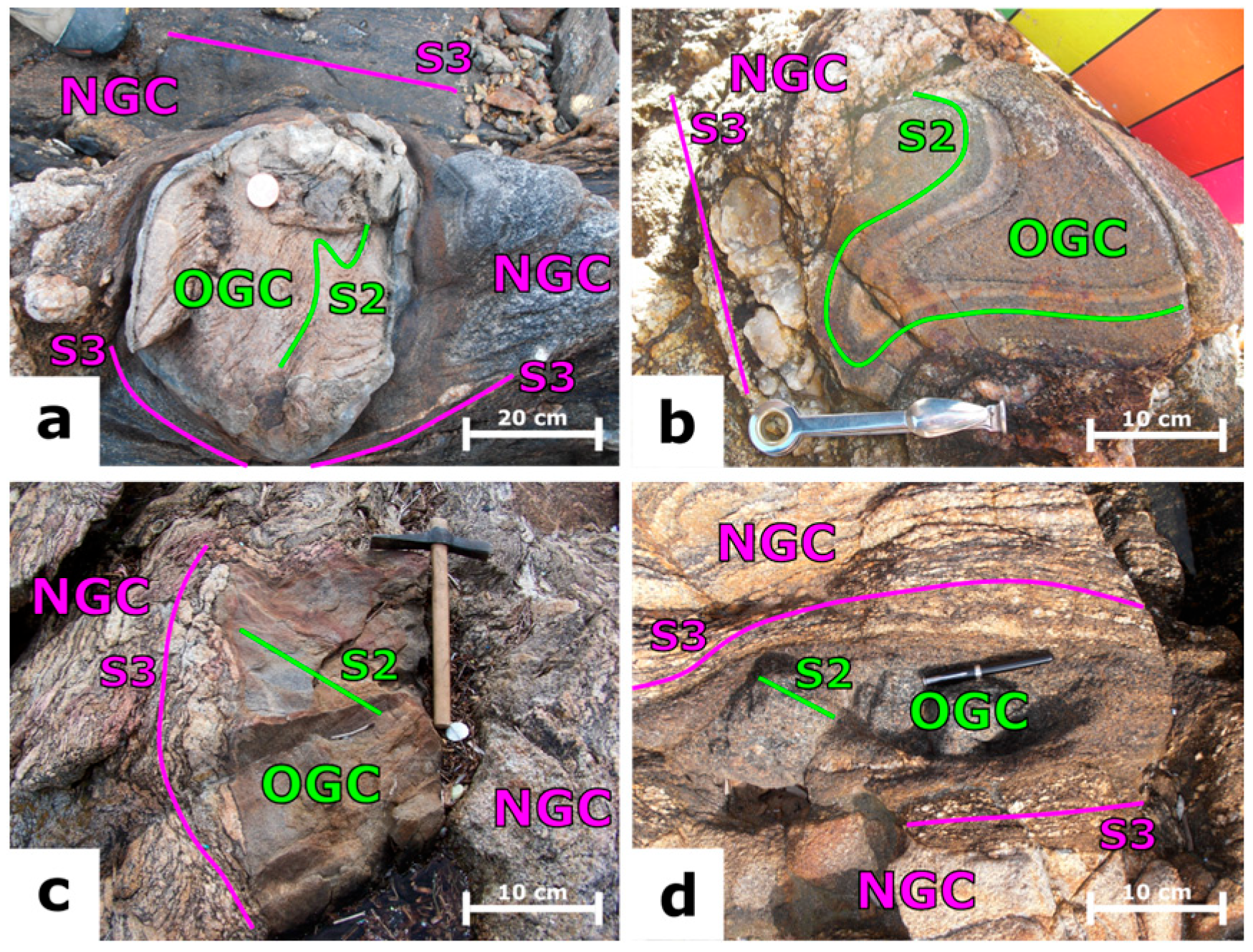
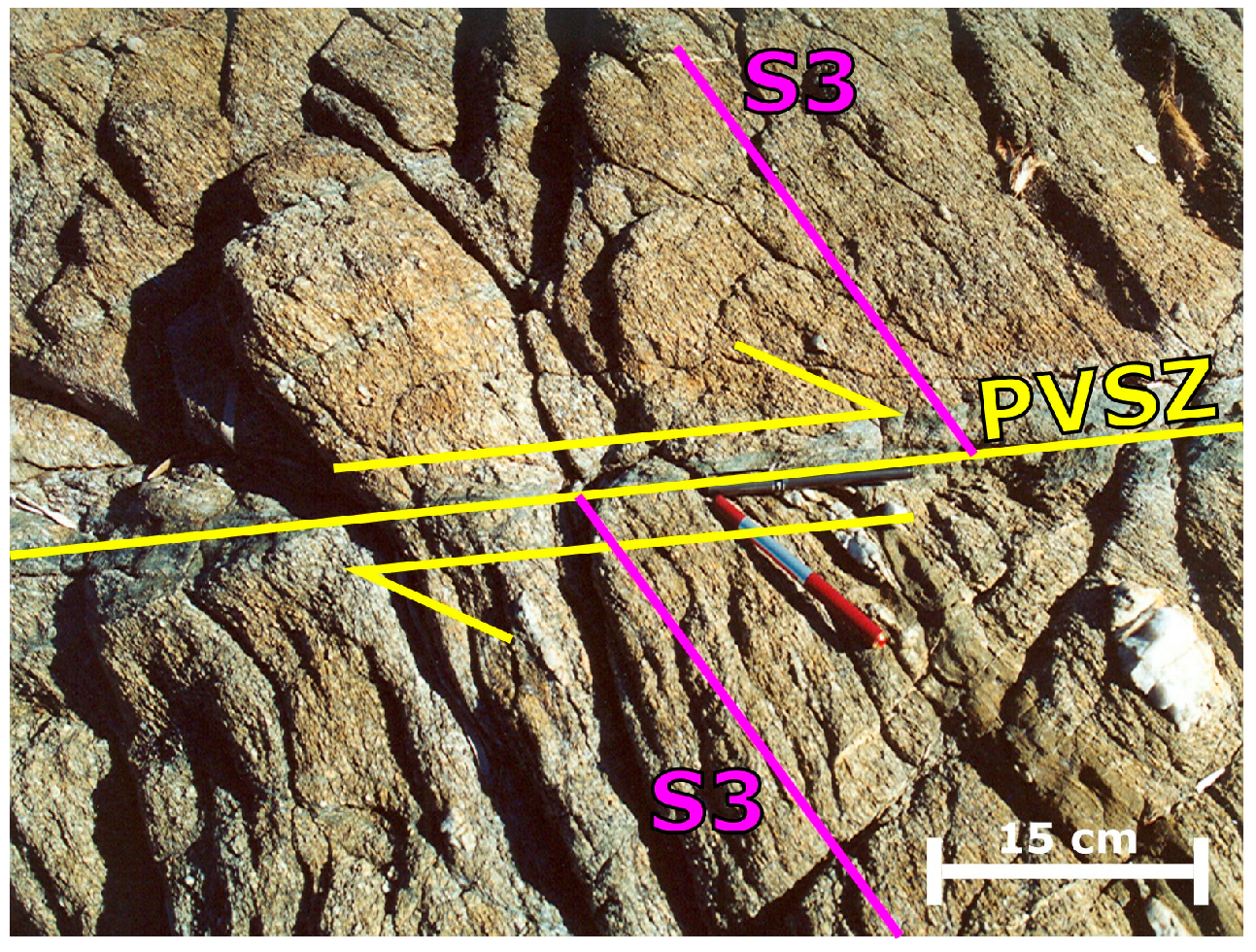
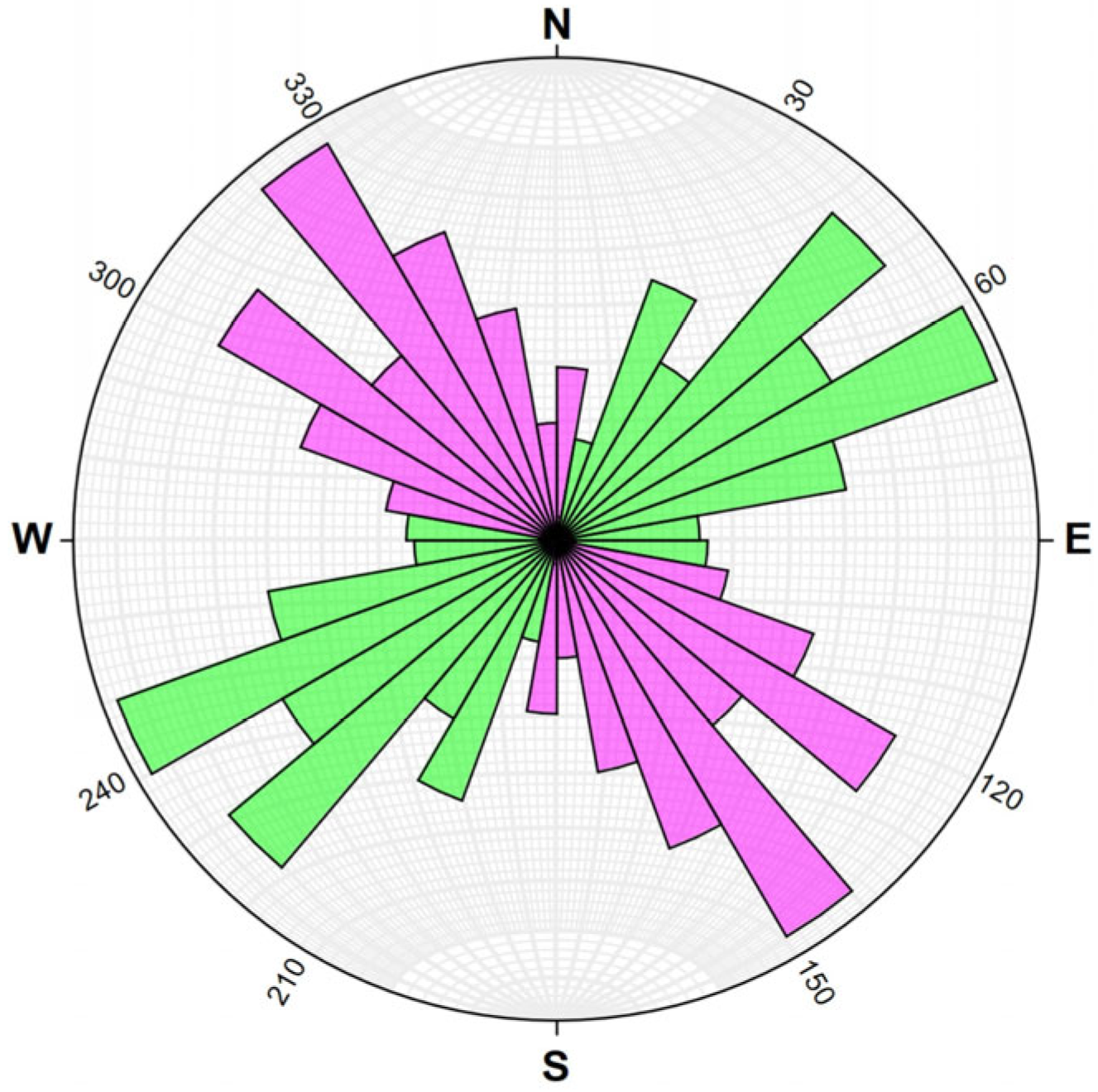
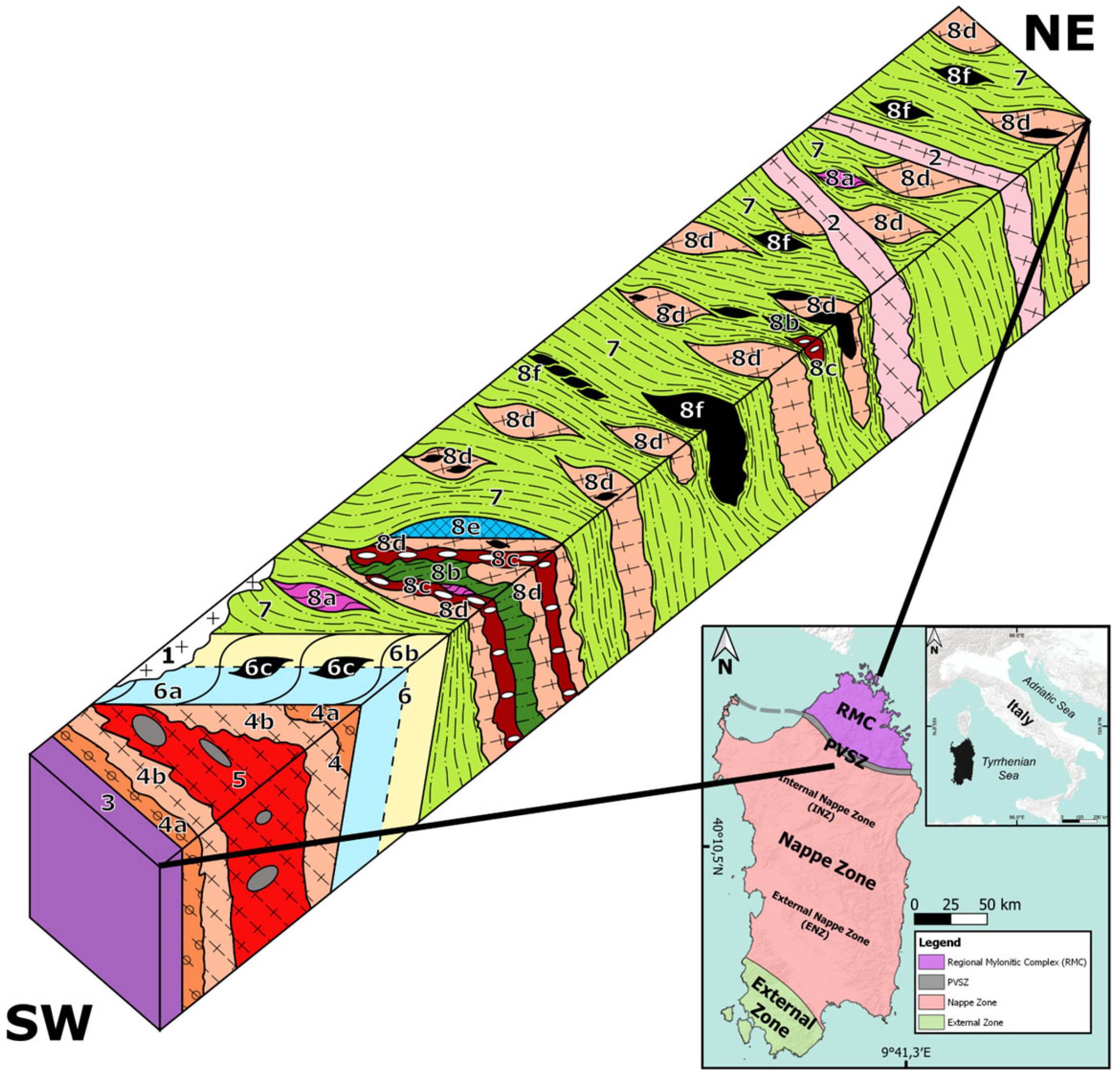
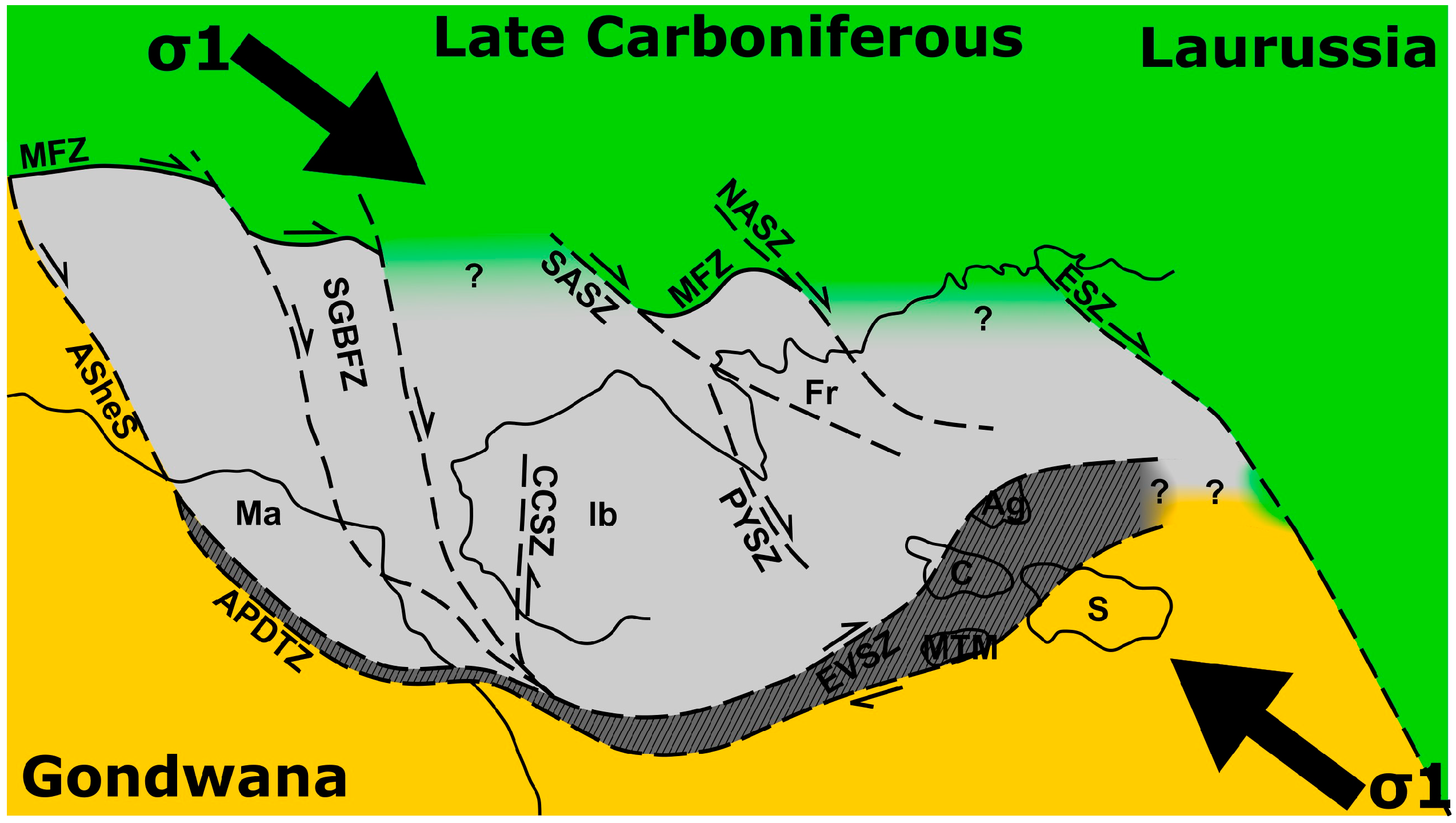
| D2 | M2 | Granulite stage (650–750 °C; 8–12 Kb at 352 ± 3 Ma) | Isolated relics of metamorphic banding (S2) within the Ky-bearing gneiss and granulites. Rare kinematic indicators show a top-to-NW component of shear. |
| D2a | - | - | Intertectonic associated with rare, tight folds, which deformed the S2 foliation only in quartzitic nodules. |
| D3 | M3 | Amphibolite stage (550–740 °C; 3–7 Kb at 344 ± 7 Ma) | Strain facies shear-parallel foliation (S3) and shear-parallel lineation (ab-foliation/a-lineation). NW–SE mineral lineations defined by rods/pencils of Pl and Qz, as well as Sil and Ms. Kinematic indicators with top-to-SE component of shear. |
| D4 | M4 | Greenschist to sub-greenschist stage (300–400 °C; 2–3 Kb at 300 Ma) | Ab-shear-parallel foliation (S4) and a-shear-parallel mineral lineation. Kinematic indicators, consistent with an NW–SE dextral sense of shear. Coeval emplacement of the Barrabisa NW–SE syn-tectonic granite. |
| D5 | - | - | Several folds of different morphological types, with NE–SW and NW–SE axes. |
| Elter et al., 2010 [28] | This Paper | ||||
|---|---|---|---|---|---|
| D2 | M2 | Granulite stage (650–750 °C; 8–12 Kb at 352 ± 3 Ma) | D2 | M2 | Granulite stage (650–750 °C; 8–12 Kb at 352 ± 3 Ma) followed by amphibolite stage (550–740 °C; 3–7 Kb at 344 ± 7 Ma) |
| D2a | - | - | |||
| D3 | M3 | Amphibolite stage 550–740 °C; 3–7 Kb a7 344 ± 7 Ma) | |||
| D4 | M4 | Greenschist stage (300–400 °C; 2–3 Kb at 300 Ma) | D3 | M3 | Greenschist stage (300–400 °C; 2–3 Kb) |
| D5 | - | - | D4 | - | - |
| Age | Tectonic Frame | Magmatism | Metamorphism | Planar Anisotropy | P-T Condition |
|---|---|---|---|---|---|
| 290 | - | Emplacement of calc-alkaline granitoid suite | - | - | - |
| 300 | PVSZ (dextral strike–slip top to E) | Greenschist stage | Sm in the PVSZ | 300–400 °C; 2–3 Kb | |
| 310 | |||||
| 315 | EVSZ (dextral strike–slip top to SE) | Capo Ferro Granite | S3 | ||
| 320 | |||||
| 330 | - | ||||
| 340 | Laurussia–Gondwana transpressional event (top to SE) | - | Granulite to amphibolitic stage | S2 | 650–750 °C and 8–12 Kb; 550–740 °C and 3–7 Kb |
| 350 | - | ||||
| 360 | - |
Disclaimer/Publisher’s Note: The statements, opinions and data contained in all publications are solely those of the individual author(s) and contributor(s) and not of MDPI and/or the editor(s). MDPI and/or the editor(s) disclaim responsibility for any injury to people or property resulting from any ideas, methods, instructions or products referred to in the content. |
© 2024 by the authors. Licensee MDPI, Basel, Switzerland. This article is an open access article distributed under the terms and conditions of the Creative Commons Attribution (CC BY) license (https://creativecommons.org/licenses/by/4.0/).
Share and Cite
Mantovani, F.; Elter, F.M. The East Variscan Shear Zone (EVSZ) and Its Regional Mylonitic Complex: A New Geodynamic Interpretation of the Variscan Axial Zone in Sardinia (Italy)? Geosciences 2024, 14, 113. https://doi.org/10.3390/geosciences14050113
Mantovani F, Elter FM. The East Variscan Shear Zone (EVSZ) and Its Regional Mylonitic Complex: A New Geodynamic Interpretation of the Variscan Axial Zone in Sardinia (Italy)? Geosciences. 2024; 14(5):113. https://doi.org/10.3390/geosciences14050113
Chicago/Turabian StyleMantovani, Federico, and Franco Marco Elter. 2024. "The East Variscan Shear Zone (EVSZ) and Its Regional Mylonitic Complex: A New Geodynamic Interpretation of the Variscan Axial Zone in Sardinia (Italy)?" Geosciences 14, no. 5: 113. https://doi.org/10.3390/geosciences14050113







